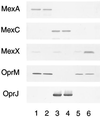Substrate specificities of MexAB-OprM, MexCD-OprJ, and MexXY-oprM efflux pumps in Pseudomonas aeruginosa
- PMID: 11083635
- PMCID: PMC90200
- DOI: 10.1128/AAC.44.12.3322-3327.2000
Substrate specificities of MexAB-OprM, MexCD-OprJ, and MexXY-oprM efflux pumps in Pseudomonas aeruginosa
Abstract
To find the exact substrate specificities of three species of tripartite efflux systems of Pseudomonas aeruginosa, MexAB-OprM, MexCD-OprJ, and MexXY-OprM, we constructed a series of isogenic mutants, each of which constitutively overproduced one of the three efflux systems and lacked the other two, and their isogenic mutants, which lacked all these systems. Comparison of the susceptibilities of the constructed mutants to 52 antimicrobial agents belonging to various groups suggested the following substrate specificities. All of the efflux systems extrude a wide variety of antimicrobial agent groups, i.e., quinolones, macrolides, tetracyclines, lincomycin, chloramphenicol, most penicillins (all but carbenicillin and sulbenicillin), most cephems (all but cefsulodin and ceftazidime), meropenem, and S-4661, but none of them extrude polymyxin B or imipenem. Extrusion of aminoglycosides is specific to MexXY-OprM, and extrusion of a group of the beta-lactams, i.e., carbenicillin, sulbenicillin, ceftazidime, moxalactam, and aztreonam, is specific to MexAB-OprM. Moreover, MexAB-OprM and MexCD-OprJ extrude novobiocin, cefsulodin, and flomoxef, while MexXY-OprM does not. These substrate specificities are distinct from those reported previously.
Figures

Similar articles
-
Extrusion of penem antibiotics by multicomponent efflux systems MexAB-OprM, MexCD-OprJ, and MexXY-OprM of Pseudomonas aeruginosa.Antimicrob Agents Chemother. 2002 Aug;46(8):2696-9. doi: 10.1128/AAC.46.8.2696-2699.2002. Antimicrob Agents Chemother. 2002. PMID: 12121960 Free PMC article.
-
Expression of Pseudomonas aeruginosa multidrug efflux pumps MexA-MexB-OprM and MexC-MexD-OprJ in a multidrug-sensitive Escherichia coli strain.Antimicrob Agents Chemother. 1998 Jan;42(1):65-71. doi: 10.1128/AAC.42.1.65. Antimicrob Agents Chemother. 1998. PMID: 9449262 Free PMC article.
-
Alterations of susceptibility of Pseudomonas aeruginosa by overproduction of multidrug efflux systems, MexAB-OprM, MexCD-OprJ, and MexXY/OprM to carbapenems: substrate specificities of the efflux systems.J Infect Chemother. 2002 Dec;8(4):371-3. doi: 10.1007/s10156-002-0193-7. J Infect Chemother. 2002. PMID: 12525903
-
Efflux as a mechanism of resistance to antimicrobials in Pseudomonas aeruginosa and related bacteria: unanswered questions.Genet Mol Res. 2003 Mar 31;2(1):48-62. Genet Mol Res. 2003. PMID: 12917802 Review.
-
Role of Efflux Pumps on Antimicrobial Resistance in Pseudomonas aeruginosa.Int J Mol Sci. 2022 Dec 13;23(24):15779. doi: 10.3390/ijms232415779. Int J Mol Sci. 2022. PMID: 36555423 Free PMC article. Review.
Cited by
-
Hacking the Permeability Barrier of Gram-Negative Bacteria.ACS Cent Sci. 2022 Aug 24;8(8):1043-1046. doi: 10.1021/acscentsci.2c00750. Epub 2022 Aug 10. ACS Cent Sci. 2022. PMID: 36032757 Free PMC article. No abstract available.
-
RND type efflux pump system MexAB-OprM of Pseudomonas aeruginosa selects bacterial languages, 3-oxo-acyl-homoserine lactones, for cell-to-cell communication.BMC Microbiol. 2012 May 10;12:70. doi: 10.1186/1471-2180-12-70. BMC Microbiol. 2012. PMID: 22574700 Free PMC article.
-
Identification of the PA1113 Gene Product as an ABC Transporter Involved in the Uptake of Carbenicillin in Pseudomonas aeruginosa PAO1.Antibiotics (Basel). 2020 Sep 11;9(9):596. doi: 10.3390/antibiotics9090596. Antibiotics (Basel). 2020. PMID: 32933058 Free PMC article.
-
Molecular Simulations of Gram-Negative Bacterial Membranes: A Vignette of Some Recent Successes.Biophys J. 2015 Aug 4;109(3):461-8. doi: 10.1016/j.bpj.2015.06.050. Biophys J. 2015. PMID: 26244728 Free PMC article. Review.
-
Genetic determinants involved in the susceptibility of Pseudomonas aeruginosa to beta-lactam antibiotics.Antimicrob Agents Chemother. 2010 Oct;54(10):4159-67. doi: 10.1128/AAC.00257-10. Epub 2010 Aug 2. Antimicrob Agents Chemother. 2010. PMID: 20679510 Free PMC article.
References
-
- Gotoh N, Tsujimoto H, Nomura A, Okamoto K, Tsuda M, Nishino T. Functional replacement of OprJ by OprM in the MexCD-OprJ multidrug efflux system of Pseudomonas aeruginosa. FEMS Microbiol Lett. 1998;165:21–27. - PubMed
-
- Iso Y, Irie T, Nishino Y, Motokawa K, Nishitani Y. A novel 1 beta-methylcarbapenem antibiotic, S-4661. Synthesis and structure-activity relationships of 2-(5-substituted pyrrolidin-3-ylthio)-1-beta-methylcarbapenems. J Antibiot (Tokyo) 1996;49:199–209. - PubMed
Publication types
MeSH terms
Substances
LinkOut - more resources
Full Text Sources
Other Literature Sources

